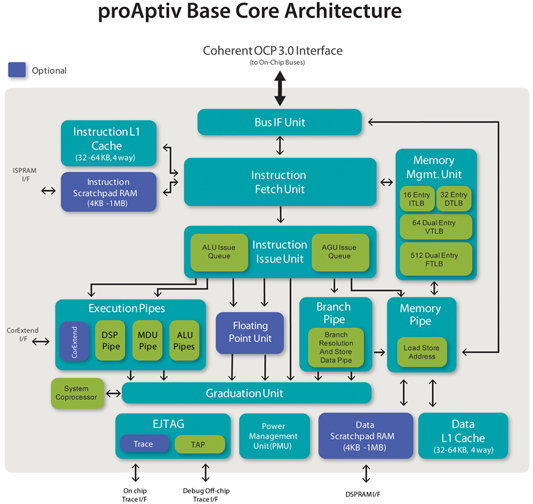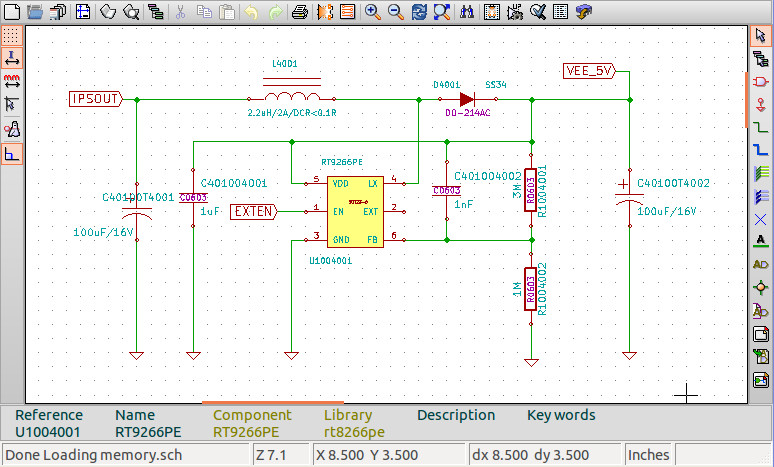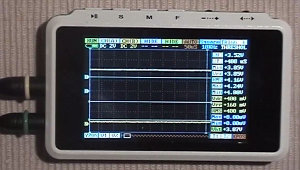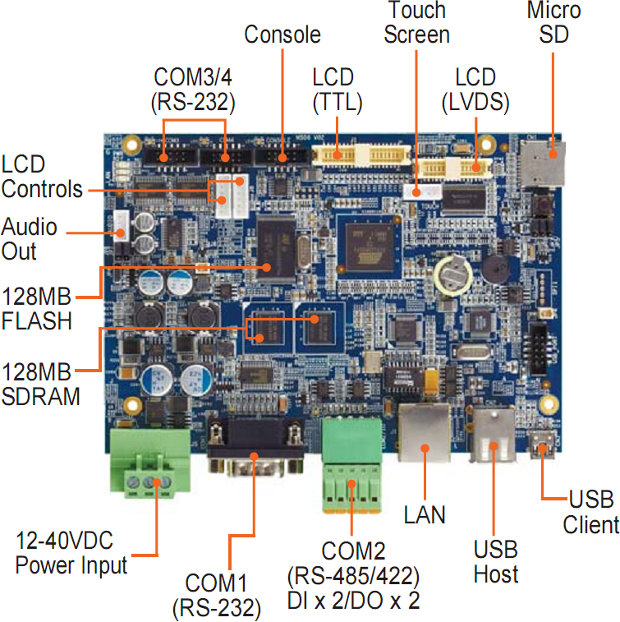Atmel announced 14 new Atmel AVR microcontrollers divided into 4 families: AVR XMEGA C, tinyAVR ATtiny1634, AVR UC3 L3 and AVR UC3 D4. Atmel AVR XMEGA C MCUs Atmel AVR XMEGA C MCUs are 8-/16-bit general-purpose MCUs with Full-Speed USB, 12-bit ADC, up to 384 KB flash and 32 KB SRAM. They can support Atmel QTouch Library for implementation of capacitive buttons, sliders and wheels functionality. The AVR XMEGA C MCUs consume 700nA in sleep mode with RTC. There 8 new XMEGA C MCUs which target consumer, industrial and home automation applications such as thermostats with display, building and climate control, utility meters with RF and ZigBee connectivity. The smallest XMEGA C MCU (ATxmega16C4), which comes in 44-pin package and has 16KB device, is the cheapest AVR XMEGA device with USB provided by Atmel. You can find further information on Atmel AVR XMEGA C page. Atmel tinyAVR ATtiny1634 MCU Atmel […]
MIPS Introduces microAptiv, interAptiv and proAptiv Cores
MIPS Technologies has introduced their new Aptiv generation of microprocessor cores divided into 3 families: proAptiv, interAptiv and microAptiv. proAptiv Core (equivalent to ARM Cortex A15 DMIPS/Mhz) The proAptiv core achieves a 4.4 CoreMark/MHz score which according to MIPS is the best score reported for any licensable IP core. It also achieves 3.5 DMIPS/MHz which is abnout the same performance as ARM Cortex A15. This core targeted at high performance applications such as smartphones, tablets, HD STB, automotive infotainment and residential gateways. proAptiv is recommended as an upgrade to MIPS32 74K/1074K cores. interAptiv Core (equivalent to ARM Cortex-R5 DMIPS/Mhz) The multi-threaded interAptiv core delivers higher CoreMark/MHz (3.2) than competing cores in similar die area and 1.7 DMIPS/MHz per core. The interAptiv is aimed at mid-range applications such as mainstream STB, digital cameras, mid-range smartphone, broadband CPE (Consumer Premise Equipment) and SATA/SSD controllers. microAptiv Core (equivalent to ARM Cortex-M3/M4 DMIPS/Mhz) The […]
Intel Roadmap to 2015 and Beyond: 5nm Technology, Merrifield Mobile Processor, Microservers and More
Intel had their annual Investor meeting day on the 10th of May 2012 in Santa Clara where we would learn a few things about what’s ahead for Intel and the semiconductor industry. Paul Otellini, Intel President and Chief Executive Officer, started the meeting by giving some numbers about Intel results and showing opportunities existing for cloud and data center, personal computing, mobile devices and intelligent systems (for automotive, retail and communications markets). One interesting point was the tremendous growth in data Intel expects from 2,500 Exabytes per year (7 EB/day) today to 8,000 Exabytes by 2015 which the majority of the growth lead by Big data. He also boasted about Intel technology advantage. For example, Intel introduced High-K Metal Gate technology in 2007 and competitor only got it in products last year (btw Samsung Exynos 5 uses HKMG). They recently introduced Tri-gate technology and they only expect competitors to catch […]
Schematics Capture and PCB Layout in Linux with Kicad
Most schematics capture and PCB layout software run on Windows and are closed source. But if your favorite OS is Linux, there are a few open source software including Kicad and gEDA. There is also Cadsoft Eagle which can be installed in Linux with a free license for hobbyists and educational purposes, but is not open source. Today, I’ll focus on Kicad. I don’t really capture schematics, let alone layout PCBs, but I sometimes need to use this type of software to locate pins/components on the schematics and PCB and check some parts of the schematics that can affect software. So I will mainly give an overview of Kicad and write my experience trying to import another project (Beagleboard XM) to Kicad. If you want to learn how to get started with your own project with Kicad, you might want to have a look at Teho Labs Kicad Tutorial. In […]
makeSD Script to Write Image to SD Card for Mele A1000 / AllWinner A10 Devices
Most images released for Mele A1000 (Ubuntu, Puppy Linux..) won’t fit in my SD card, and until now I had to manually partition the SD card, extract the data and copy it to the SD card. I’ve also noticed the size of the SD card slowly creeps lower overtime. I bought an SD card last week and fdisk reported 3901685760 bytes and this morning the same command reported 3898782720 bytes. That’s probably due to new bad sectors which I believe is actually normal for this type of device. The problem is that a backup of “last week” SD card done with dd might not be restored properly with dd since the SD card is now smaller. So I decided to write a shell script “makeSD.sh” that will do the following: Umount the SD card if needed Partition the SD card Copy uboot to the SD card Mount the image file […]
VWorks VLAB Powers Freescale Vybrid Virtual Platform
Back in March, Freescale announced their Vybrid solution featuring both a Cortex A5 processor and a Cortex M4 microcontroller, and they had prototypes running an unnamed virtual platform in order to speed up software development and possibly have the software ready at the same time as the silicon is. Always looking to learn more, I studied and wrote about virtual hardware platforms such as Cadence Virtual System Platform, Wind River Simics Virtual Platforms and the open source Imperas OVPsim simulator. It turns out Freescale does not use any of these solutions, but relies on VWorks VLAB instead, which still use the same standard (SystemC/TLM) as the virtual hardware solutions aforementioned. VWorks uploaded a demonstration of VLAB running a virtual platform for the Freescale Vybrid controller and showing how it can handle both ARM Cortex-A5 and Cortex-M4 cores. This demo of VLAB 1.7.0 is pretty interesting and showcases: Dual (virtual) display […]
199 USD Seeed Studio DSO Quad Open Source Oscilloscope
The DSO (Digital Storage Oscilloscope) Quad is a pocket size 4 channel digital oscilloscope for common electronic engineering tasks based on STM32F103VCT6 ARM cortex M3 MCU with a 3″ display. It can provide 72MS/s sampling rate with integrated FPGA and high speed ADC and an internal 2MB USB disk can be used to store waveform captures, user applications and to upgrade firmware. SeeedStudio DSO Quad is not exactly a new product (June 2011), but I was not aware of this type of low cost oscilloscopes until I come across a review today. Here are the key features of this tiny oscilloscope: Pocket size and light weight Two 72MS/s analog channels, plus two digital channels Signal Generator Auto Measurement Various Triggering Option Easy waveform storage Firmware upgrade User applications Open source and technical specifications: 2x Analog channel: [CH A] [CH B] 2x Digital channel : [CH C] [CH D] Vertical […]
Artila M-506 and M-606 ARM9 Industrial Single Board Computers
Artila Electronics announced 2 new single board computers (SBC) based on Atmel SAM9G45 ARM9 Processor: Artila M-506 running Linux 2.6.38 Artila M-606 running Wince 6.0 Both models features the same hardware with a standard 3.5” form factor, Atmel AT91SAM9G45 Processor, 128MB DDR2 RAM, 128MB NAND Flash and 2MB DataFlash and only differ by the operating system and software used. The company explains that the board targets industrial application such as intelligent transportation system (ITS), building automation, energy-saving system, and scenario control systems. Here are the hardware specifications for both devices: CPU – ATMEL AT91SAM9G45 @ 400MHz Memory – 128MB SDRAM Flash – 128MB NAND & 2MB DataFlash for system recovery On-board TTL/LVDS LCD interface Supports 5V/12V TFT LCD panels, up to 1280 x 860 pixels Ethernet: 1x, 10/100Mbps COM port – 3x RS-232, 1x RS-422/485 USB Host – 4x USB 2.0 HS ports. Micro-SD Card – 16GB max. GPIO – […]













